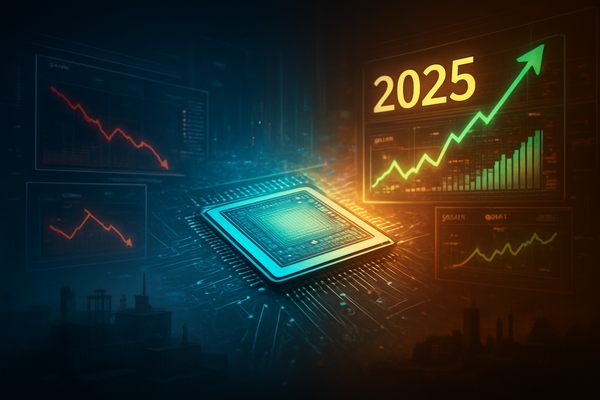Gold and Silver Navigate Choppy Waters: A Short-Term Recovery in Focus

As October 2025 draws to a close, the precious metals market finds itself at a critical juncture, with gold hovering near the significant $4,000 per ounce mark and silver demonstrating notable resilience around $48.77 per ounce. After a dramatic late-October pullback that saw both metals shed considerable value from their recent all-time highs, investors are now weighing signs of stabilization against persistent macroeconomic headwinds. The short-term recovery outlook for these traditional safe havens is being heavily influenced by a newly established U.S.-China trade truce and a surprisingly firm U.S. dollar, creating a complex interplay of forces that could dictate their immediate trajectory.
The recent volatility underscores a period of tactical retreat for gold and silver, which had previously enjoyed an impressive nine-week rally, pushing gold to nearly $4,400 an ounce and silver above $54 an ounce. This correction, largely attributed to profit-taking after reaching "overbought" technical conditions, has led to a cautious reassessment of their bullish momentum. While improved global trade sentiment has somewhat dampened the traditional safe-haven appeal, the underlying demand, coupled with central bank activity and silver's robust industrial applications, suggests a market poised for a measured recovery, albeit one fraught with potential challenges from a resilient greenback.
Market Dynamics: A Closer Look at Gold and Silver's Recent Journey
The closing weeks of October 2025 were characterized by significant price swings for both gold and silver. Following an impressive ascent that saw gold reach historic peaks near $4,400 an ounce and silver surge past $54 an ounce, a sharp correction ensued. This selloff, which ended an extended nine-week rally, witnessed gold tumble by 6-7% and silver by over 10%. This downturn was primarily driven by extensive profit-taking as both metals entered "overbought" territory according to technical indicators, prompting investors to lock in substantial gains. However, as the month concludes, both metals have shown promising signs of finding a floor. Gold, despite daily fluctuations, has largely held steady around the $4,000 level, positioning itself for a third consecutive monthly gain, up nearly 3.9% for October. Silver, in particular, has demonstrated robust short-term momentum, climbing 0.38% on the last day of the month and extending its weekly gains to over 3%, largely bolstered by strong industrial demand. Year-to-date, gold has advanced approximately 50%, while silver has surged by 60%, highlighting their enduring appeal despite the recent dip.
A significant development influencing this market behavior is the improved global trade sentiment, most notably a newly established U.S.-China trade truce. This agreement, focusing on rare earth metals and strategic resources, alongside reduced tariffs on certain products, has injected a short-term sense of calm into global markets. While this truce is a positive for broader economic stability, it has concurrently dampened some of the safe-haven demand that traditionally supports precious metals. Analysts are quick to point out that while this provides temporary relief, any resurgence of geopolitical tensions could swiftly redirect investor interest back to gold and silver, highlighting the fragile nature of this sentiment.
Adding another critical layer to the market dynamics is the firmer U.S. dollar. The Bloomberg Dollar Spot Index has exhibited considerable strength, primarily fueled by a hawkish stance from the Federal Reserve. Following a recent quarter-point interest rate cut, Fed Chair Jerome Powell's subsequent comments downplaying the likelihood of another reduction in December have bolstered the dollar, pushing it to a three-month high. A stronger dollar typically makes dollar-denominated assets such as gold and silver more expensive for international buyers, thereby capping their upside potential and contributing to the profit-taking witnessed in late October. This inverse relationship between the dollar and precious metals remains a crucial factor in their short-term outlook.
Key players in this evolving scenario include central banks, which have been consistent buyers of gold, providing a fundamental floor for prices. Large institutional investors and hedge funds also play a significant role, with their positioning and sentiment often dictating short-term price movements. Mining companies, such as Barrick Gold (NYSE: GOLD) and Newmont Corporation (NYSE: NEM), are directly impacted by price fluctuations, as their profitability is intrinsically linked to the market value of the metals they extract. The initial market reaction to these combined factors has been a period of consolidation, with many investors viewing the recent dips as potential buying opportunities, particularly for silver, given its dual role as both a monetary and industrial metal.
Corporate Fortunes: Winners and Losers in the Precious Metals Arena
The current market conditions, characterized by a delicate balance of improved trade sentiment, a firmer U.S. dollar, and fluctuating precious metal prices, will inevitably create winners and losers among public companies directly and indirectly involved in the gold and silver sectors. Mining companies stand at the forefront of this impact, with their profitability directly tied to the price of the metals they extract.
Gold mining giants like Barrick Gold (NYSE: GOLD) and Newmont Corporation (NYSE: NEM) could see their fortunes swing based on the sustained recovery of gold prices. A firmer U.S. dollar, while generally a headwind for gold, also implies a potentially stronger U.S. economy, which could translate to lower operational costs for some U.S.-based miners if energy and labor costs stabilize. However, if the dollar's strength continues to suppress gold prices, these companies might face reduced revenue per ounce, impacting their margins and profitability. Conversely, a strong recovery in gold, fueled by renewed safe-haven demand or inflationary pressures, would significantly boost their earnings and stock valuations.
Silver miners, such as Wheaton Precious Metals (NYSE: WPM) and Pan American Silver (NASDAQ: PAAS), are uniquely positioned due to silver's dual role as both a monetary and industrial metal. While a firmer dollar might weigh on silver's monetary appeal, the strong industrial demand, particularly from the booming solar and electric vehicle (EV) sectors, could provide a robust floor for prices. Companies supplying silver to these high-growth industries stand to benefit significantly, potentially offsetting some of the negative impact from a strong dollar. A sustained surge in industrial demand could lead to increased production and higher revenues for these miners, irrespective of short-term currency fluctuations.
Furthermore, companies involved in precious metals exchange-traded funds (ETFs) like SPDR Gold Shares (NYSEARCA: GLD) and iShares Silver Trust (NYSEARCA: SLV) will see their asset under management (AUM) and investor interest fluctuate directly with metal prices. A period of recovery and consolidation could attract new inflows, benefiting these fund providers. On the other hand, a prolonged period of stagnation or further price corrections could lead to outflows, impacting their fee-based revenues. Overall, the ability of these companies to manage operational costs, hedge against currency risks, and adapt to shifting market sentiment will be crucial in determining their success in the evolving precious metals landscape.
Wider Significance: Beyond the Bullion Markets
The current dynamics in the gold and silver markets, influenced by improved trade sentiment and a firm U.S. dollar, carry broader significance that extends far beyond the immediate price movements of these precious metals. This scenario fits into larger global economic trends, particularly concerning inflation, central bank policies, and geopolitical stability. The U.S.-China trade truce, while a positive for global commerce, also reflects a broader effort to de-escalate trade tensions that have characterized much of the mid-2020s. This de-escalation can reduce systemic risk, which, paradoxically, lessens the urgency for safe-haven assets like gold and silver. However, the fragility of such agreements means that any renewed friction could quickly reverse this trend, sending investors scrambling back to precious metals.
The persistent strength of the U.S. dollar, driven by a hawkish Federal Reserve stance, has ripple effects across various markets. A stronger dollar typically pressures other commodity prices, as they become more expensive for buyers holding other currencies. This could impact energy prices, agricultural commodities, and base metals, potentially dampening global inflationary pressures. For emerging markets, a strong dollar can make dollar-denominated debt more expensive to service, leading to potential financial instability. Conversely, a robust dollar can attract capital flows to the U.S., bolstering equity markets and U.S. Treasury bonds. The interplay between the dollar, interest rates, and inflation expectations is a critical barometer for global financial health.
From a regulatory and policy perspective, central bank actions, particularly those of the Federal Reserve, remain paramount. The Fed's signals regarding future monetary policy, including any further interest rate adjustments or quantitative tightening measures, will profoundly influence not only the dollar but also the attractiveness of non-yielding assets like gold. Many central banks globally have continued to accumulate gold, viewing it as a strategic reserve asset and a hedge against currency fluctuations and geopolitical uncertainties. This consistent institutional demand provides a fundamental underpinning for gold prices, acting as a counterweight to short-term market pressures.
Historically, periods of improved trade sentiment have often coincided with a reduction in safe-haven demand, leading to consolidation or even corrections in precious metal prices. Similarly, a strong dollar environment has typically put downward pressure on gold and silver. However, current circumstances are unique due to the elevated levels of global debt, ongoing geopolitical tensions (despite the U.S.-China truce), and persistent inflationary concerns that have emerged post-pandemic. These factors suggest that while short-term headwinds exist, the underlying rationale for holding precious metals as a hedge against systemic risks remains robust, distinguishing the current environment from simpler historical precedents.
The Road Ahead: Navigating Future Scenarios
Looking ahead, the short-term and long-term possibilities for gold and silver are shaped by a confluence of economic indicators, geopolitical developments, and central bank policies. In the short term, the market is likely to remain in a consolidation phase. Gold is expected to trade within a defined range, with strong support levels around $3,900-$3,950 per ounce, suggesting that dips could be viewed as buying opportunities. For silver, its dual nature as both a monetary and industrial metal lends it resilience. Continued robust demand from the solar and electric vehicle (EV) sectors is anticipated to provide a strong floor, potentially pushing silver towards the $50-$52 per ounce range if industrial activity remains strong.
Potential strategic pivots for investors will involve closely monitoring inflation data, the Federal Reserve's communications, and the durability of the U.S.-China trade agreement. If inflation proves to be more persistent than anticipated, or if geopolitical tensions unexpectedly flare up, the safe-haven appeal of gold and silver could quickly reignite, leading to a renewed bullish run. Conversely, if the U.S. dollar continues its ascent and global trade remains stable, precious metals might face sustained pressure, necessitating a more cautious investment approach.
Market opportunities could emerge from targeted investments in silver, given its strong industrial demand narrative, potentially outperforming gold in the short to medium term. Additionally, gold mining companies that demonstrate strong cost controls and healthy balance sheets could present attractive entry points during periods of price consolidation. Challenges include the risk of a stronger-than-expected dollar, which could cap upside potential, and the possibility of a full-fledged global economic recovery that diminishes safe-haven demand.
Several potential scenarios could unfold. In a "Goldilocks" scenario, where the U.S. economy achieves a soft landing and inflation moderates without aggressive Fed tightening, gold and silver might experience a gradual, steady ascent, supported by underlying demand. In a "Stagflationary" scenario, characterized by high inflation and slow growth, both metals would likely thrive as investors seek hedges against eroding purchasing power. Finally, a "Deflationary Shock" scenario, though less likely given current trends, would be detrimental to precious metals, as liquidity would be prioritized over safe havens. Investors should prepare for adaptability, carefully weighing these potential outcomes.
Concluding Thoughts: Resilience in a Complex Market
The current state of gold and silver, as October 2025 concludes, paints a picture of resilience amidst a complex and often contradictory market environment. While both precious metals have experienced a tactical retreat from their recent all-time highs, they have demonstrated a remarkable ability to stabilize, with gold holding near $4,000 per ounce and silver showing robust momentum driven by industrial demand. The key takeaways from this period are the nuanced impacts of improved trade sentiment and a firmer U.S. dollar. The U.S.-China trade truce, while fostering global economic calm, has temporarily reduced safe-haven demand. Concurrently, a hawkish Federal Reserve stance has bolstered the dollar, making precious metals more expensive for international buyers and contributing to recent profit-taking.
Moving forward, the market for gold and silver will be a delicate balancing act. While the immediate headwinds from a strong dollar and reduced geopolitical uncertainty are undeniable, the underlying drivers for precious metals remain potent. Persistent central bank buying, ongoing inflationary concerns, and silver's critical role in green energy technologies provide a fundamental floor for prices. Investors should assess these factors carefully, recognizing that dips may present strategic buying opportunities, particularly for silver given its strong industrial narrative.
The lasting impact of these events will depend on the sustained nature of the U.S.-China trade truce and the Federal Reserve's future monetary policy trajectory. Any deviation from the current path – be it renewed trade tensions, an unexpected surge in inflation, or a dovish pivot by the Fed – could swiftly alter the outlook for gold and silver. Investors should closely watch forthcoming inflation data, central bank pronouncements, and geopolitical developments in the coming months. These will be the primary catalysts determining whether gold and silver embark on a sustained bullish recovery or continue to navigate a period of consolidation, offering both challenges and opportunities in the evolving financial landscape.
This content is intended for informational purposes only and is not financial advice



